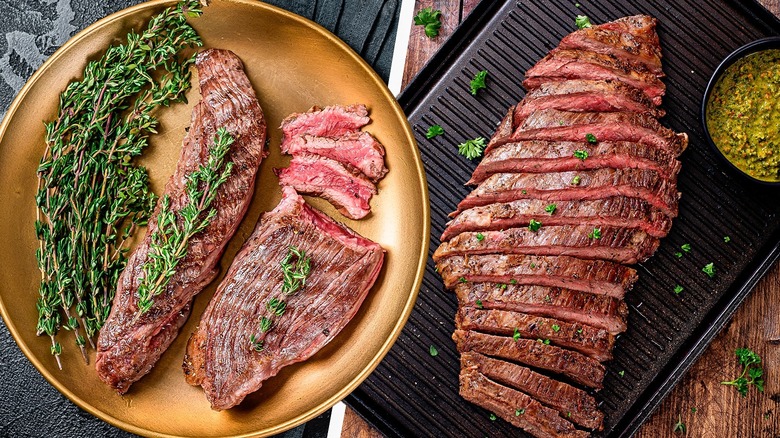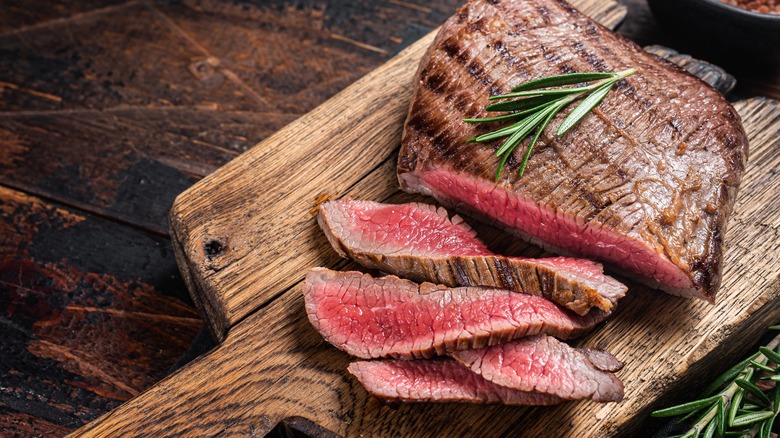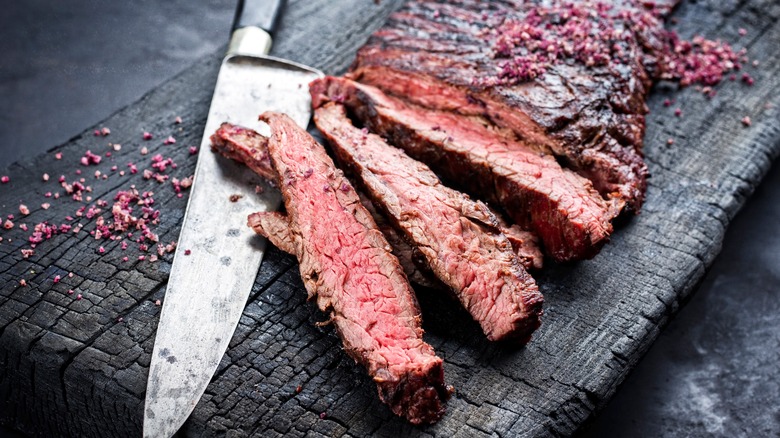The Differences Between Flank And Bavette Steak
Choosing the right cut of steak can be overwhelming, to the point that some obscure cuts are often ignored in favor of more familiar choices like sirloin, rump, or T-bone. When it comes to cuts that sit fairly close together on the animal, such as the flank and bavette, understanding their differences can be tricky.
A bavette cut sits on the lower end of the bottom sirloin, just above the flank, and it's also known as a flap steak. Its name is an abbreviated version of the French phrase, "bavette d'aloyau," which means, "bib of the sirloin." Flank, on the other hand, is pretty self-explanatory and refers to the area between the cow's ribs and hips. You may see bavette and flank used interchangeably in some scenarios, but to conflate the two is to overlook their unique characteristics and flavor potential.
While cooking methods and seasonings will partially determine your steak's taste, each cut's naturally-occurring flavor and texture are heavily influenced by how each body part is used. Cuts taken from areas that see heavier use (around the legs and flank, for example) tend to be leaner and chewier thanks to the build-up of muscle tissue. Areas that see less use, such as the tenderloin, are softer and more likely to melt in your mouth. Fattier cuts like rump are lined with marbling — fatty deposits that melt during cooking and infuse your meat with delicious bursts of additional flavor.
Flank is tough but not impossible to work with
Flank steak is one of the cheapest cuts you can buy, but it's rarely a top pick compared to other affordable steaks. This is likely because of its texture, as it's among the toughest cuts out there. The flank is one of the cow's hardest-working areas, so it's laced with long lines of muscle fiber instead of tasty fat deposits. Bavette, on the other hand, is slightly thicker and contains plenty of marbling. Flank does possess a strong beefy flavor on its own, but its lack of extra flavor pockets knocks it down a few pegs when compared to more marbled cuts.
If taken at face value, these factors make bavette look wildly superior; however, you can use the flank's toughness to your advantage. Because it's so lean, flank steak can take on seasonings and marinades better than more tender cuts. This makes flank a great choice for season-heavy meals like Thai basil beef or vaca frita, both of which pack loads of extra flavor into the meat. Alternatively, if you heat the steak in a slow cooker, you can have the best of both worlds: tender meat thanks to the long, low heat exposure, plus a lean cut of meat that's primed for flavor infusion. If you're often busy throughout the week, try whipping up some crockpot steak fajitas with a cut of flank.
Bavette is a diamond in the rough
Unlike the well-known flank, bavette is a hidden gem. It's known colloquially as the "butcher's cut," because the professionals allegedly keep it for themselves. It does, however, have limitations. Bavette is more tender than flank, but it's not exactly a filet. Like the flank, its placement on the cow's heavily-used haunches means it's densely packed with fiber and muscle tissue. This creates a graininess that somewhat overshadows the meat's flavor — there's little point in achieving a delicious taste if the mouthfeel makes every bite unpleasant.
Avoiding a grainy bavette is all about preparation. Be sure to use a marinade recipe with a mixture of salt, acid, and flavor; the acid component, in particular, will help denature the sinew and create taste pockets. Cooking bavette requires a bit more care than flank, as the marbling can easily dry out if overcooked — this cut should always be served rare. Bavette usually has a thin end and a thick end, so watch it carefully to ensure it cooks evenly (or use a tenderizer to flatten it).
Because the cut is so delicious when made properly, you don't need to drown it in extras, like flank — its flavor stands alone. Pair it with some light, tasty sweetcorn or upgrade to a corn puree for a rich, steakhouse-worthy dinner.


